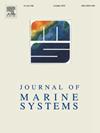总有机碳动力学:南大洋夏季印度板块的分配、分布和控制过程
IF 2.5
3区 地球科学
Q2 GEOSCIENCES, MULTIDISCIPLINARY
引用次数: 0
摘要
南大洋(SO)是连接太平洋、大西洋和印度洋的全球重要区域,具有极端的季节变化,对碳动态至关重要。有机碳在海洋的各种生物地球化学过程和碳生物泵中起着至关重要的作用。本研究讨论了两个南方夏季南大洋印度板块不同锋面上总有机碳(TOC)的变化及其颗粒和溶解组分的划分。TOC分布年际变化较大,2013年TOC浓度变化范围为84.4 ~ 127.8 μM, 2015年TOC浓度变化范围为76.3 ~ 121.2 μM, TOC分布年际变化较大。研究表明,浮游植物优势群落对上层水体有机碳组成和分配以及中上层水体微生物呼吸的变化起着重要作用。此外,浮游动物群落及其放牧效应影响了水柱内有机碳动态。此外,总有机碳与温度、表观氧利用率和溶解无机碳的显著相关性表明,水团入侵和漩涡等物理混合过程相互作用。生化反应改变了TOC的分布。重要的是,即使是像SO变暖这样的小气候变化也会刺激水文过程、食物网结构和碳途径的变化,影响海洋生态系统中有机碳的命运。本文章由计算机程序翻译,如有差异,请以英文原文为准。
Dynamics of Total organic carbon: Partitioning, distribution and controlling processes in the Indian sector of the Southern Ocean during austral summer
The Southern Ocean (SO) is a globally important region connecting the Pacific, Atlantic and Indian Oceans, having extreme seasonal changes and is crucial with regard to the carbon dynamics. Organic carbon plays a vital role in various biogeochemical processes and the carbon biological pump in the ocean. This study discusses the variability of total organic carbon (TOC) and its partitioning into particulate and dissolved fractions across the different fronts of the Indian sector of the Southern Ocean during two austral summers. A considerable interannual variation in the TOC distribution was noted, TOC concentration ranged from 84.4 to 127.8 μM in 2013 and from 76.3 to 121.2 μM in 2015, with considerable interannual variation in the TOC distribution. This study implied that the dominant phytoplankton community substantially contributed to the changes in composition and partitioning of organic carbon in the epipelagic waters and microbial respiration in the mesopelagic waters. Besides, the zooplankton community and its grazing effect influenced the organic carbon dynamics within the water column. Also, a significant correlation of total organic carbon with temperature, apparent oxygen utilisation and dissolved inorganic carbon, suggests the interplay of physical mixing processes like water mass intrusion and eddies. With biochemical responses altering the TOC distribution. Importantly, even small climate changes like warming in the SO can stimulate alterations in hydrographic processes, the food web structure and carbon pathways, impacting the fate of organic carbon in the oceanic ecosystem.
求助全文
通过发布文献求助,成功后即可免费获取论文全文。
去求助
来源期刊

Journal of Marine Systems
地学-地球科学综合
CiteScore
6.20
自引率
3.60%
发文量
81
审稿时长
6 months
期刊介绍:
The Journal of Marine Systems provides a medium for interdisciplinary exchange between physical, chemical and biological oceanographers and marine geologists. The journal welcomes original research papers and review articles. Preference will be given to interdisciplinary approaches to marine systems.
 求助内容:
求助内容: 应助结果提醒方式:
应助结果提醒方式:


